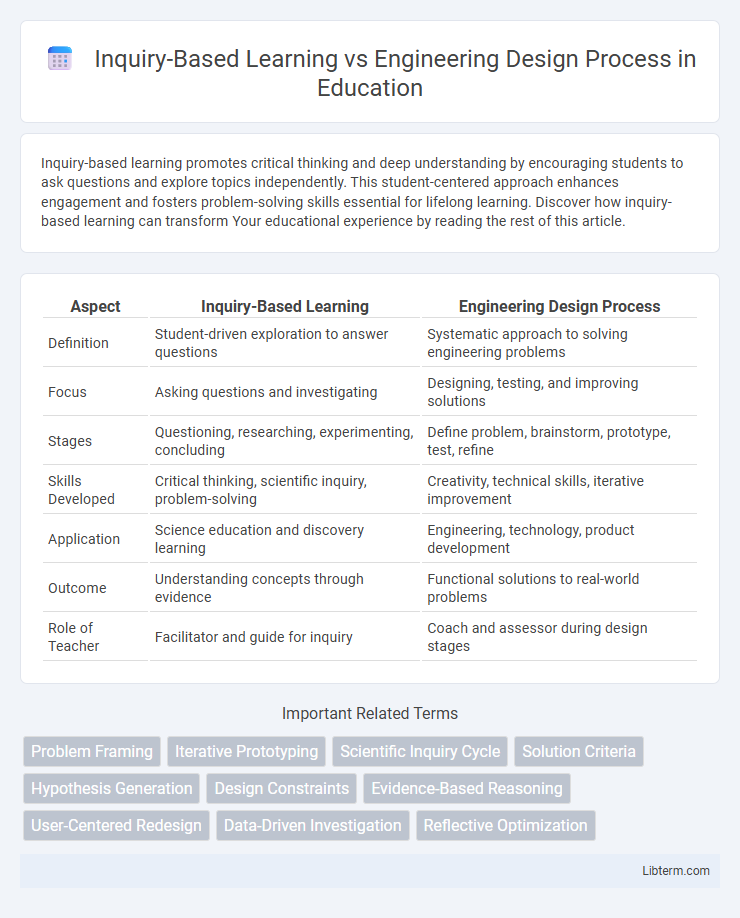Inquiry-based learning promotes critical thinking and deep understanding by encouraging students to ask questions and explore topics independently. This student-centered approach enhances engagement and fosters problem-solving skills essential for lifelong learning. Discover how inquiry-based learning can transform Your educational experience by reading the rest of this article.
Table of Comparison
| Aspect | Inquiry-Based Learning | Engineering Design Process |
|---|---|---|
| Definition | Student-driven exploration to answer questions | Systematic approach to solving engineering problems |
| Focus | Asking questions and investigating | Designing, testing, and improving solutions |
| Stages | Questioning, researching, experimenting, concluding | Define problem, brainstorm, prototype, test, refine |
| Skills Developed | Critical thinking, scientific inquiry, problem-solving | Creativity, technical skills, iterative improvement |
| Application | Science education and discovery learning | Engineering, technology, product development |
| Outcome | Understanding concepts through evidence | Functional solutions to real-world problems |
| Role of Teacher | Facilitator and guide for inquiry | Coach and assessor during design stages |
Introduction to Inquiry-Based Learning and Engineering Design Process
Inquiry-Based Learning emphasizes student-driven questioning, investigation, and critical thinking to construct knowledge through exploration and experimentation. The Engineering Design Process involves systematic problem-solving steps such as defining problems, brainstorming solutions, prototyping, testing, and iterating to develop functional products or systems. Both frameworks foster hands-on learning and creativity but differ in focus: Inquiry-Based Learning centers on understanding concepts through inquiry, while the Engineering Design Process targets the creation of practical, engineered solutions.
Defining Inquiry-Based Learning
Inquiry-Based Learning centers on student-driven exploration where learners pose questions, conduct investigations, and build understanding through active discovery. This educational approach emphasizes critical thinking and problem-solving by engaging students in authentic, open-ended inquiries rather than following step-by-step instructions. Unlike the linear Engineering Design Process, Inquiry-Based Learning fosters flexible, iterative investigation cycles that adapt as new questions and insights emerge.
Understanding the Engineering Design Process
The Engineering Design Process (EDP) is a systematic, iterative method used by engineers to develop functional products and solutions by defining problems, brainstorming ideas, creating prototypes, testing, and refining designs. It emphasizes problem-solving through specific stages such as requirement analysis, concept development, and optimization, which distinguishes it from Inquiry-Based Learning's focus on questioning and investigation. Mastery of the EDP enables students and professionals to apply critical thinking and technical skills to real-world engineering challenges efficiently.
Core Principles Compared
Inquiry-Based Learning centers on questioning, exploration, and evidence-based reasoning to build understanding, emphasizing student-driven investigation and critical thinking skills. The Engineering Design Process prioritizes defining problems, brainstorming solutions, prototyping, and iterative testing to develop functional outcomes, focusing on practical application and refinement. Both approaches foster creativity and problem-solving but differ in their primary focus on knowledge acquisition versus solution development.
Steps Involved in Both Approaches
Inquiry-Based Learning involves steps such as posing questions, conducting investigations, analyzing data, and drawing conclusions to foster deeper understanding. The Engineering Design Process includes defining a problem, brainstorming solutions, creating prototypes, testing, and iterating designs for practical application. Both approaches emphasize iterative exploration and critical thinking but differ in their focus on scientific inquiry versus solution-oriented design.
Educational Goals and Learning Outcomes
Inquiry-Based Learning emphasizes student-driven questioning and investigation to develop critical thinking skills and deeper understanding of scientific concepts, promoting curiosity and problem-solving abilities. The Engineering Design Process focuses on applying iterative design, testing, and refinement to create functional solutions, enhancing practical skills and collaboration in real-world problem contexts. Both approaches aim to foster creativity and analytical thinking but differ in their primary focus: conceptual exploration versus tangible product development.
Classroom Implementation Strategies
Inquiry-Based Learning (IBL) and the Engineering Design Process (EDP) both enhance critical thinking and problem-solving skills in classroom implementation. IBL emphasizes student-driven questioning and exploration, utilizing strategies like guided discussion, hypothesis testing, and reflective journaling to deepen understanding. EDP incorporates iterative stages such as defining problems, brainstorming solutions, prototyping, and testing, with classroom activities centered around hands-on projects and collaborative teamwork for real-world application.
Benefits and Challenges of Each Approach
Inquiry-Based Learning fosters critical thinking and deep understanding by encouraging students to explore questions and develop knowledge independently, but it may challenge learners who require more structured guidance. The Engineering Design Process emphasizes iterative problem-solving and real-world application, promoting creativity and practical skills, though it can be time-intensive and sometimes limits open-ended exploration. Both approaches enhance STEM education by developing essential skills, yet educators must balance structure and flexibility to address diverse student needs effectively.
Integrating Both Methods in STEM Education
Integrating Inquiry-Based Learning and the Engineering Design Process in STEM education enhances critical thinking and problem-solving skills by encouraging students to explore scientific concepts through questioning while applying iterative design solutions. This combined approach supports hands-on investigations and real-world application, fostering deeper understanding and innovation. Research shows that STEM learners engaged in both methods demonstrate improved creativity, collaboration, and technological literacy essential for 21st-century careers.
Conclusion: Choosing the Right Approach for Your Classroom
Selecting the appropriate method for your classroom depends on the specific learning objectives, as Inquiry-Based Learning fosters critical thinking and curiosity through student-driven questioning, while the Engineering Design Process emphasizes systematic problem-solving and iterative design. Both approaches encourage collaboration and hands-on engagement, but tailoring the choice to align with subject matter and student needs maximizes educational outcomes. Integrating elements of both can create a comprehensive STEM curriculum that supports diverse learning styles and skill development.
Inquiry-Based Learning Infographic

 libterm.com
libterm.com